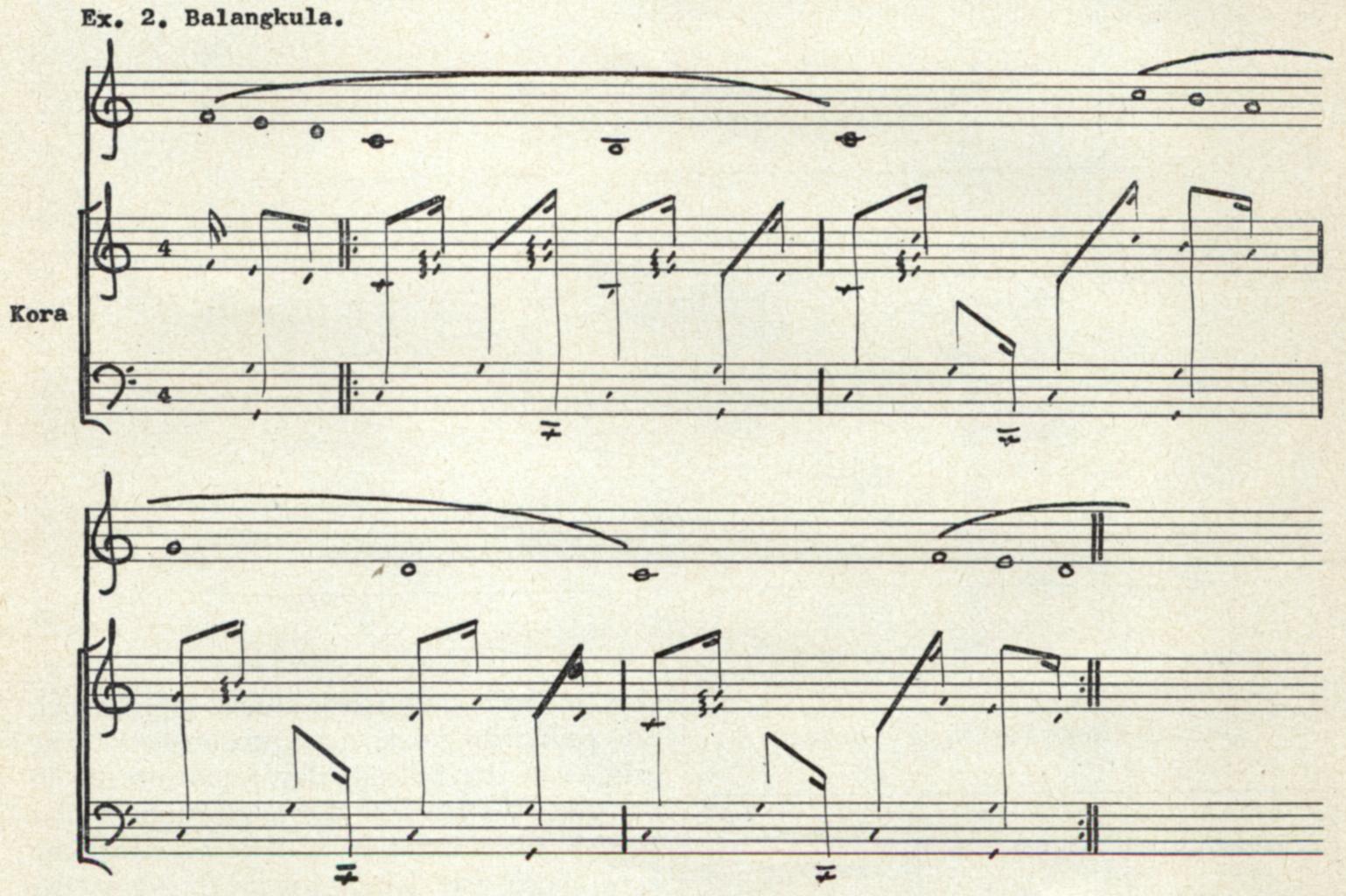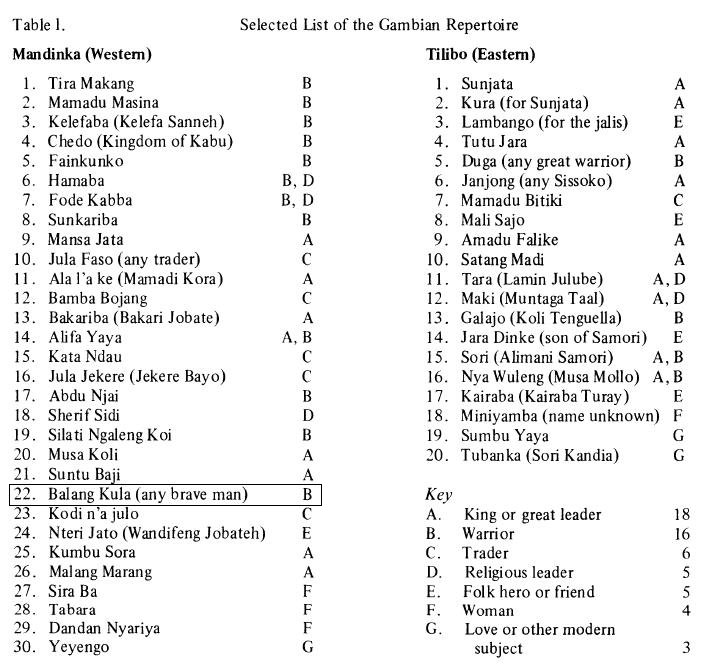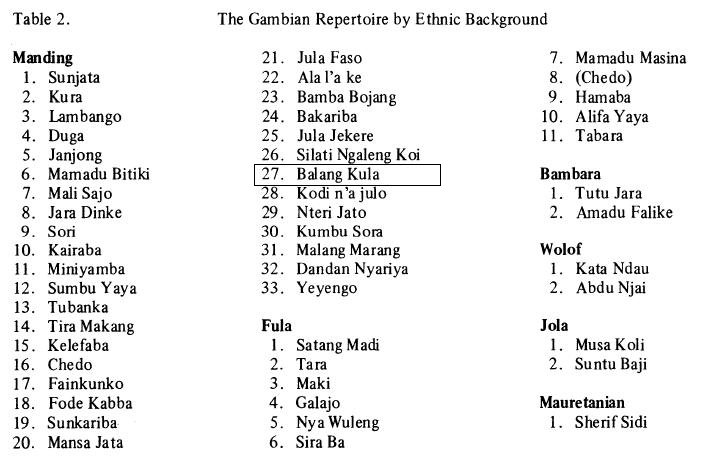faringbulo
King, Anthony P. 1974. "Musical Tradition in Modern Africa." Journal of the Royal Society of Arts 123 (5221): 15-23.
(Balangkula)
p. 18

Knight, Roderic. 1982a. "Manding/Fula Relations as Reflected in the Manding Song Repertoire." African Music 6 (2): 37�47.
(Balang Kula)
p. 39
Table One . . . includes the best known, most often heard, or otherwise significant songs in the [Gambian] repertoire. In each column the top few songs are the oldest, and the bottom few are the youngest. The majority in each case fall somewhere in between (often in the nineteenth century), but no chronological ordering beyond this is intended, since it is often not possible to date a song exactly. Most of the songs bear the name of their owner as the title. Where they do not, his name is shown in parentheses next to the title. The letter code at the right represents the person's "claim to fame" or calling in life, as shown in the bottom of the list.

p. 40
Table Two shows the same fifty songs again, grouped this time by the ethnic background of the people commemorated.

Konte, Bai. 1982. Konte Family Mandinka Music: Kora Music and Songs from The Gambia. Virgin, VX 1006.
(Balankula)
Balankula was probably composed in the early part of this century in Casamance, south of The Gambia. The title means "The Refuser," and as its refrain says, "If you are going to refuse something, then stick to your words!" Bai explains that to call someone a "Refuser" is a way of praising him, because it means that his actions live up to his words.
Jessup, Lynne. 1983. The Mandinka Balafon: An Introduction with Notation for Teaching. La Mesa, Calif.: Xylo.
(Faringbulo)
p. 32
"Faringbulo" was the first piece of music that nine of the jalis [of the twenty interviewed] learned to play, "Lambango" was the first tune for four others. "Kelefaba" and "Jakaa" were learned first by two other jalis. In addition, ten of the jalis said they learned to play songs in a set order. Yet no two jalis listed the songs in the same order.
p. 50
In order to discover the core repertoire, all jalis interviewed were asked to list the pieces they knew and to indicate which five were their favorite pieces. Although "Faringbulo" is the first piece to be learned by many apprentices, no one mentioned it as one of their favorites.
pp. 98�100
Donkilo (on teaching tape)
| Fere wo ye | Fere (a type of dance) |
| Fere wo ye | wo ye (has no real meaning, but is often used in singing, |
| Fere wo ye | like "uh huh" is used in English) |
| Dongnaa Jilenba | Dongnaa (dancer); Jilenba (a woman's name) |
Related information
"Faringbulo" has been included in this collection because it is the first tune learned by the Suso Jalis. Also known as "Balan Kula," it is not easier than the other kumbengos. Jalis don't differentiate among kumbengos by degree of difficulty; they merely say that some kumbengos take longer to learn than others, and the degree of difficulty comes from the Jali's own facility with birimintingo. However, as in this example, they will sometimes designate a kumbengo as a master's version.
pp. 146�59 (Appendix 2: Balafon Repertoire)
| Title | Faringbulo |
| Translation: | Come and dance, Faring |
| Dedication: | Faring (name) |
| Notes: | a.k.a. Balangkula on the kora |
| Calling in Life: | Warrior |
| Original Instrument: | ? |
| Region of Origin: | Manding (Western Coastal Region) |
| Date of Origin: | M (19th & 20th c. up to WWII) |
| Sources: | ? |
Haydon, Geoffrey, and Dennis Marks, dirs. 1984. Repercussions: A Celebration of African American Music. Program 1. Born Musicians: Traditional Music from The Gambia. Chicago: Home Vision.
(Farimbuloo)
SJ: What was the first piece played on the baloo?*
MS: Well, that is a controversial issue among historians but in my home when you learn the baloo the first piece you are taught is called "Farimbuloo."
SJ: How is it played? Can you demonstrate it?
MS: Yes. There are two ways of playing it. In my home a learner first plays Farimbuloo in this way. This is the way we teach a new learner just like children starting their schooling with ABC. If one masters these notes, remembering which ones go together, it's not difficult to go on from there, as long as one always remembers the notes in relation to each other.
SJ: It sounds like the kumbengo.
MS: Yes, it's the basic pattern for Farimbuloo.
SJ: You said it could be played in two ways. This is the first, what is the second?
MS: The second way is what we call "Sinkonding Farimbuloo."
* Transcription mine. Orthography based on Jatta (1985).